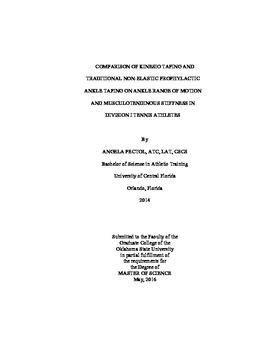| dc.contributor.advisor | Defreitas, Jason | |
| dc.contributor.author | Pectol, Angela Marie | |
| dc.date.accessioned | 2017-02-22T22:16:08Z | |
| dc.date.available | 2017-02-22T22:16:08Z | |
| dc.date.issued | 2016-05-01 | |
| dc.identifier.uri | https://hdl.handle.net/11244/49137 | |
| dc.description.abstract | Context: Kinesio tape (KT) is an elastic tape that can be utilized in any phase of injury as an intervention for increasing lymphatic drainage, facilitating or inhibiting muscle activity, providing ligament and tendon support and functional correction. While the KT brand claims to provide patients a variety of therapeutic benefits, there is limited research to support these claims. Objective: The purpose of this study was to compare the effect of KT for functional correction by assisting dorsiflexion (DF) and eversion (EV) and inhibiting plantar flexion (PF) and inversion (IV). Design: Randomized crossover study design. Setting: Clinical setting. Patients/Participants: 19 Division I Tennis Athletes, 10 males and 9 females. Interventions: Participants were randomly assigned to start with no tape (NT), KT or traditional, non-elastic tape (WT) and randomly assigned to start with PF/DF or IV/EV for a one-time test on the Biodex 3 isokinetic dynamometer. Main Outcome Measure(s): Each participant�s range of motion (ROM) and musculotendinous were measured using a Biodex 3 isokinestic dynamometer. Musculotendinous stiffness was calculated as the slope of the angle-torque curve generated by the Biodex 3. Results: No significant difference was found between NT and KT for ROM and MTS in any direction of ankle motion. A significant decrease in ROM was found between NT and WT for PF and EV, as well as MTS of the dorsiflexion muscle group. Significant differences were found between WT and KT for PF ROM and the DF muscle group. Conclusion: Results of this study do not support the claims of KT for functional correction to assist dorsiflexion and eversion and inhibit plantar flexion and inversion. These results do not justify the use of KT as an alternative to traditional, non-elastic prophylactic tape for preventing ankle injuries. Key words: Kinesio tape, musculotendinous stiffness, range of motion, ankle tape, taping, ankle sprains. | |
| dc.format | application/pdf | |
| dc.language | en_US | |
| dc.rights | Copyright is held by the author who has granted the Oklahoma State University Library the non-exclusive right to share this material in its institutional repository. Contact Digital Library Services at lib-dls@okstate.edu or 405-744-9161 for the permission policy on the use, reproduction or distribution of this material. | |
| dc.title | Comparison of Kinesio Taping and Traditional Non-elastic Prophylactic Ankle Taping on Ankle Range of Motion and Musculotendinous Stiffness in Division I Tennis Athletes | |
| dc.contributor.committeeMember | Volberding, Jennifer | |
| dc.contributor.committeeMember | O'brien, Matthew | |
| osu.filename | Pectol_okstate_0664M_14638.pdf | |
| osu.accesstype | Open Access | |
| dc.description.department | Health & Human Performance (MS) | |
| dc.type.genre | Thesis | |
| dc.type.material | text | |
